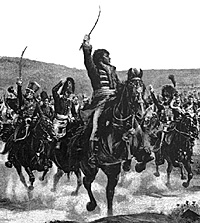 Also at Historicon 94, three of our EE&L Staff (Marc Raiff, Bill Jessop and Jean Lochet) presented a paper on French cavalry called "The Organization, Strategic and Tactical Involvement of the French Cavalry During the Empire," which eventually will find its way into a future
issue of EE&L. The paper was well received by the audience and we are going to upgrade our lecture and present a much improved version at Cold Wars 95 with more diagrams to illustrate the maneuvers, especially the ones at the Battle of Austerlitz.
Also at Historicon 94, three of our EE&L Staff (Marc Raiff, Bill Jessop and Jean Lochet) presented a paper on French cavalry called "The Organization, Strategic and Tactical Involvement of the French Cavalry During the Empire," which eventually will find its way into a future
issue of EE&L. The paper was well received by the audience and we are going to upgrade our lecture and present a much improved version at Cold Wars 95 with more diagrams to illustrate the maneuvers, especially the ones at the Battle of Austerlitz.
Many were surprised by the strength of the Cavalry Reserve and at the increase in the strength of the French squadrons from 1805 to 1812. In our paper, we gave a number of definitions among which is that of Cavalry Reserve and its usage:
To avoid misinterpretation, let us define Reserve which under the Empire had a different meaning. It was not a specific force kept for the final push or for the last part of the battle, but rather a kind of cavalry "pool" in which were kept readily available, fast moving forces to be used where the military situation required them.
So, the initial assignment of cavalry formations, in both the Cavalry Reserve and individual corps, was not a rigid system but rather was one that could change anytime the circumstances or specific missions required it. So, the Emperor dipped into the Cavalry Reserve to increase the available cavalry of this or that corps, or, inversely, the cavalry of any corps could be withdrawn and transferred to another corps or into the Cavalry Reserve.
The location and the strength of the Cavalry Reserve could even change during the course of a battle. In theory, there was an enormous mass of cavalry under Murat's command, but, in reality, that command was very tenuous and employed as a mass sporadically, such as at Eylau where a charge of 80 squadrons became an irresistible torrent of horses and men, breaking everything in front of it.
In addition, the lecture answered a number of questions and the partial answers are worth reporting here:
Question (1) What was the strength of the reorganized French cavalry at the beginning of the Empire?
- Answer: After several organization attempts, [3] the decree of the 1st Vendemaire Year XII (September 24, 1805) definitely set the composition of the French line cavalry at 80 regiments: [4]
-
Heavy Cavalry (grosse cavalerie) 14 regiments
Dragoons -- 36 regiments
Light Cavalry -- 26 regiments
Question (2) What was the average strength of the French cavalry squadrons from 1805 to 1812?
- Answer: By the same decree the official size of regiments was also established:
-
Heavy Cavalry -- 820 men
Dragoons -- 880 men
Light cavalry (1,075)
In theory, the total cavalry effective strength should have been close to 75,000 sabers, but the official returns dated September 4, 1806, i.e., just before the Campaign of 1806 against Prussia, show that the strengths for each of the 78 cavalry regiments ranged from 800 to 900
men (800 for the Heavies, 850 to 900 for the Dragoons and Lights) for a total of only 65,000 sabers of the 345,000 combatants of the Grande Armee. [5]
From then on and until 1812, the cavalry effective strength was constantly increased in an attempt to reach the officially authorized strength. In 1806, a fifth squadron was added to each
regiment as a depot squadron. [6]
In 1807, the companies of Dragoons and Light Cavalry were increased to a minimum of 128 men and the regimental strength for these units reached -- and was often over -- 1,000 sabers.
This increase in cavalry effectives lasted until 1812, when it reached 100,000 sabers. After the retreat from Russia, Napoleon's cavalry never recovered its original strength.
Question: (3) What was the strength of the Cavalry Reserve in 1812, prior to the invasion of Russia?
- Answer: At the beginning of the Campaign in Russia in 1812, the Cavalry Reserve formed no less than four corps of two to three divisions each and included no less than the
impressive total of 200 squadrons.
A number of other questions came up, among which were some on the tactical use of French Dragoons, and these subjects will be covered at length in future issues of EE&L.
Footnotes
[3] See also EE&L #5, pp.40-45, The First Consul's Cuirassiers and the French cavalry reforms.
More Reader Forum
This article appears in MagWeb (Magazine Web) on the Internet World Wide Web.
[4] In reality only 78 regiments since the 17th and 18th Chasseurs a cheval were never formed.
[5] The cavalry component was about 20% of the Grande Armee total.
[6] As a general rule, the depot squadrons were not to be fielded but were the training center for each regiment's new recruits.
Back to Empire, Eagles, & Lions Table of Contents Vol. 2 No. 9
Back to EEL List of Issues
Back to MagWeb Master Magazine List
© Copyright 1994 by Emperor's Headquarters
Other military history articles and gaming articles are available at http://www.magweb.com
